One must draw the line somewhere
dal 3/11/2004 al 11/12/2004
Segnalato da
Aleksandar Stankovski
Florian Zeyfang
Goran Dachev
Ivanka Apostolova
Jorge Queiroz
Sandra Boeschenstein
Yane Calovski
Miriam Bers
3/11/2004
One must draw the line somewhere
Galerie K&S, Berlin
The forth project of the international exchange program Her und Hin (Back and Forth), with an incentive to strengthen the links of the city of Berlin to various Eastern European regions through collaborations with art magazines, curators and artists.The exhibition connects Berlin to Skopje through D, a journal issued twice a year focusing on drawing as a practice and a medium, conceptualized and edited by artist Yane Calovski and co-published by Revolver - Archive fur aktuelle kunst.

Curated by Yane Calovski and Miriam Bers
One must draw the line somewhere is the forth project of the international exchange program Her und Hin (Back and Forth), with an incentive to strengthen the links of the city of Berlin to various Eastern European regions through collaborations with art magazines, curators and artists.The exhibition connects Berlin to Skopje through D (http://www.d-magazine.net) , a journal issued twice a year focusing on drawing as a practice and a medium, conceptualized and edited by artist Yane Calovski and co-published by Revolver - Archive für aktuelle kunst. All artists included in the exhibition have developed drawing as their primary practice referring to contexts such as science, media, film and art history as well as narrative strategies or personal histories to create a continuum of facts and fictions. Although thematically flexible, the relationship between the human form and the abstracted space becomes a connecting element throughout the exhibition.
Aleksandar Stankovski (*1959), one of the most influential artists living and working in Skopje, has created an impressive series of comic-book novels, consisting of four volumes (Labris, 1989-92, Unidentified, 1993-97, Minorities of Reality, 1998-2000; and Fun 2000-present;) of over 600 pages each. These volumes (edited and exhibited for the first time) trace the slow, yet persistent process of social disfiguration and political marginalization of the individual, drawing up parallel realities,where worlds clash, but do not collide.
Florian Zeyfang's (*1965) installations incorporate drawing, animated film and the projected image and, as articulated by Clemens Krümmel, they manage to establish film as a 'medium of truth², where the sparing use of the camera adjusts itself to the movements of the drawing-pen. This is particularly evident in the work Re-fishing Fishinger (2004), a drawing animation reconstructing the pictures of the first episode of Walt Disney's animated epic Fantasia originally drawn by Fishinger. By re-tracing the action Zeyfang allows for the emergence of a new reading of the film parelleling the film's original meaning.
Over the last fifteen years Goran Dachev (*1970) has been focusing on the development of concepts for comics that articulate issues prevalent in the social context in which he lives and works. Influenced by Robert Crumb, his drawings address police brutality, homophobia, the social alienation of the youth and the deterioration of the family unit with such humor and vigor that even the most grotesque propositions become a bearable experience.
The multi-lingual, text-based drawings of Ivanka Apostolova (*1973) are autobiographical, anti-comic style narrations. 'Conceptual, but sometimes compulsive and partially abstracted', as defined by the artist, her series of collage drawings articulate her ongoing self-reflection and the engagement with the world as it is, drawing up new provocations in the process of deciphering incoming meaning.
The drawings of Jorge Queiroz (*1966), actually fellow in Künstlerhaus Bethanien, have recently been interpreted by Knut Ebeling, as "confiscated, transformed from the classic medium of the clear thought to the final expression of the unclear.' His figures and objects, although sometimes recognizable, remain suspended in abstraction, 'actively colliding with things or with technologies, with processes and productions', constituting a modular system in which 'everything is compatible with everything else'.
Sandra Boeschenstein's (*1967) highly detailed drawings at first glance suggest the technique of scientific sketches. However, in Boeschenstein¹s case it is not easy to identify the portrayed objects and figures, nor are the texts-lines she incorporates with the images articulating a logical explanation. Within parallel constellations, the Solitude Âfellow proposes new alignments of objects vs. meanings, and at the same time reflects on, wonders about and criticizes the positivistic thinking in natural science with a healthy dose of humour.
A project by Akademie Schloss Solitude, Stuttgart and Künstlerhaus Bethanien, Berlin.
Opening reception: November 4th, 7 p.m.
The exhibition runs from November 5th, 2004 - December 11th, 2004.
The international exchange program 'Her und Hin' for Eastern European artists and curators is supported by the Allianz Kulturstiftung.
Galerie K&S
Linienstraße 156/157 10115 Berlin



